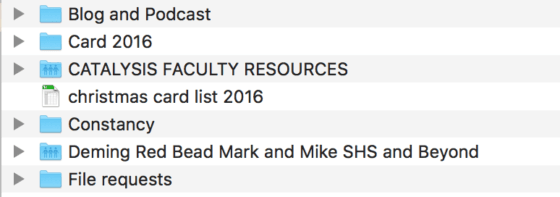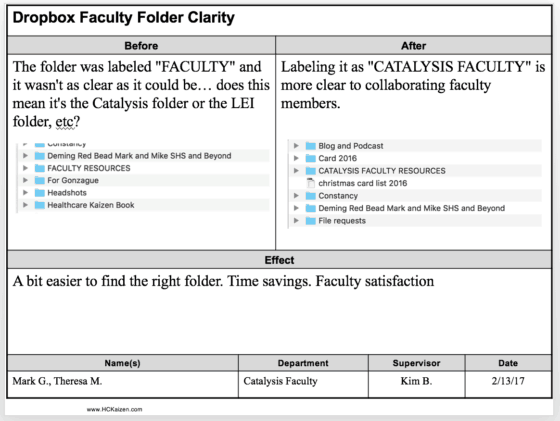Today's Post in <50 Words: In this post, I describe an idea (or a suggestion?) that led to a Kaizen improvement through Catalysis (formerly known as the ThedaCare Center for Healthcare Value).
 I really like and admire the folks at Catalysis (formerly known as the ThedaCare Center for Healthcare Value).
I really like and admire the folks at Catalysis (formerly known as the ThedaCare Center for Healthcare Value).
I worked very closely with them from 2009 to 2011 when I was an LEI employee and I continue to partner with them in different ways, with their annual Lean Healthcare Transformation Summits (check out my pre-Summit workshop on “Better Metrics” this year) and as a “faculty” member for them.
One way that we collaborate and work together is through a shared Dropbox folder.
When the folder was created and pushed out to people, it looked like this on my Mac:

Since I'm a “faculty member” for a few other organizations, including the Lean Enterprise Institute.
For the person at Catalysis, the label “FACULTY RESOURCES” makes perfect sense in her context. There's no confusion to her what that means.
For me (and maybe for other faculty), it's not clear in my folder list that this is about Catalysis.
So, I made a suggestion. I would be tempted to call this a “Kaizen” improvement, but Kaizen generally involves things that you can fix yourself and with others. This was sort of in the category of a “suggestion” because I could only bring it up. My colleague at Catalysis could make it a Kaizen from her perspective, based on my suggestion.
Maybe that distinction isn't important (but I do try to teach people that, in a Kaizen process, you can't just lob ideas at others… you should come up with some ideas that you can implement).
It took a bit of time, as the Catalysis leader wanted to get input from others on their team (and possibly from other faculty). That's fair. Even a small, easy improvement might require some discussion. Our model in the Healthcare Kaizen book, by the way is:
- Find (problems, opportunities, or ideas)
- Discuss
- Implement (or test)
- Document
- Share
Some ideas don't require much discussion — they are a “just do it.” If an idea is low risk and can be easily undone, just do it. If it's more involved or riskier, it requires more discussion… to get input, to talk about what might happen, etc.
The change was made… here's how the folder looks now, to me, as “CATALYSIS FACULTY RESOURCES.” I like that better. I consider it an improvement. It makes things a bit easier for me.

I appreciate their collaboration and continuous improvement.
I don't fault them for not considering how things look through my eyes. I give them credit for listening and responding once I spoke up.
Here's how I would write this Kaizen up, Healthcare Kaizen style:
You can download templates like this through our book's website and you can also share Kaizen examples, if you like.
What small Kaizen improvement have you implemented recently?
Have you been surprised along the way during the course of a PDSA cycle when you discovered the perspective of somebody that you hadn't considered yet? Is that to be avoided or a natural part of the PDSA process?
Please scroll down (or click) to post a comment. Connect with me on LinkedIn.
Let’s work together to build a culture of continuous improvement and psychological safety. If you're a leader looking to create lasting change—not just projects—I help organizations:
- Engage people at all levels in sustainable improvement
- Shift from fear of mistakes to learning from them
- Apply Lean thinking in practical, people-centered ways
Interested in coaching or a keynote talk? Let’s start a conversation.










![When Was the Last Time a Leader Around You Admitted They Were Wrong? [Poll]](https://www.leanblog.org/wp-content/uploads/2025/07/Lean-Blog-Post-Cover-Image-2025-07-01T212509.843-100x75.jpg)
Hello Mr.Mark Graban it was quite interesting topic kaizen in Health care system, i having a little question about health care system .is health care system having more space to with stand as well as adapt the changes by kaizen by keeping a side by the traditional system of their approach..
Hi – I’m sorry, but I really don’t understand the question…
Is health care system has any flexibility to with stand changes according to the current situations.
I still don’t understand what you are asking. I’m sorry.
Hi Mark,
Thanks for the great example on how to take “clarity” and put it in a Kaizen report. Sharing that report with others can definitely improve upon the subject of clarity for other as well in my opinion, this is absolutely great.
As a consultant, I am often faced with a conflict should I push my ideas and suggestions on people (asking them to do what I think). Or alternatively should I somehow present the problem, or make them think of the problem, and ask them to present ideas and solutions back to me. I believe that the second method is more effective, and in general gets “buy-in” more easily. But it is very difficult sometimes to control myself from being very prescriptive and pushing changes and ideas on others. This often makes people protective and resistant to changes I suggest.
Do you think it is a good idea to allow people get buy-in into ideas this way? How would you suggest the topic in the post could be approached differently given this method?
Hi Evgeny – Thanks for the comment.
You raise a great point about trying to draw out ideas. That’s definitely the ideal approach when coaching people in Kaizen.
As a consultant, sometimes you’re under pressure to provide recommendations, answers, or advice (especially when directly asked for it).
It this case, working with ThedaCare, I was more “a part of the process” instead of being a consultant. So, I think it was really appropriate for me to not just point out the problem, but also to make a suggestion.
Mark